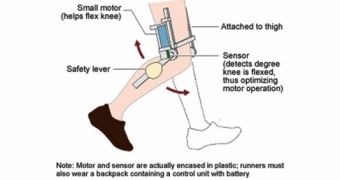Researchers in Japan are known for their affinity in the field of creating enhancement devices for the human body, allowing regular people to perform feats that they would otherwise be incapable of. This is also the case with scientists at the Tsukuba University, who recently developed a new type of accessory, in the form of a motorized knee. The device allows people to run faster than they would normally, while also using a lot less muscle forces than usually, PhysOrg reports.
The new instrument is made of two separate pieces, weighing in at five kilograms (about ten pounds) each. One component is attached to the knee of the bearer, while the other is placed inside a backpack the person wears on his or her back. The team behind the innovation emphasizes the fact that the new, motorized knee is not meant to be a prosthetics device for the handicapped, but rather an aid for regular people, who just want to be able to run faster than usually.
The knee part of the device consists of a number of sensors, placed around a motor and a safety lever. The sensors pick up the level of flex in the knee, and send the data to the motor, which adjusts its function accordingly. This ensures a smooth running process, the Tsukuba team reports. The goal is to reduce the amount of stress placed on the muscles themselves by more than 30 percent, allowing users to run steadily at a speed of 7.5 kilometers per hour. The safety lever is meant to be used in case of emergencies, if the device malfunctions in any way.
The backpack unit contains nothing more than the computing unit, and the power supplies. The system uses batteries for electricity, the team says. It also adds that the new instrument is scheduled to go on the market in less than three years, and believes that there already exists a market waiting for it out there. However, some people draw attention to the fact that the robotic accessory prevents muscular build-up, which is precisely the main reason why people jog in the first place. And since it is not designed for rehabilitation purposes, its doubtful that it could be used by patients recovering from knee replacements, or other similar surgeries.

 14 DAY TRIAL //
14 DAY TRIAL //